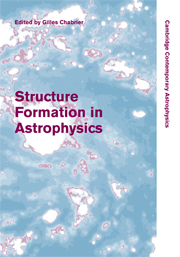Book contents
- Frontmatter
- Contents
- List of contributors
- Preface
- Part I Physical Processes and Numerical Methods Common to Structure Formations in Astrophysics
- Part II Structure and Star Formation in the Primordial Universe
- Part III Contemporary Star and Brown Dwarf Formation
- Part IV Protoplanetary Disks and Planet Formation
- 13 Observational properties of disks and young stellar objects
- 14 Structure and dynamics of protoplanetary disks
- 15 Planet formation and evolution: theory and observations
- 16 Planet formation: assembling the puzzle
- Part V Summary
13 - Observational properties of disks and young stellar objects
Published online by Cambridge University Press: 11 August 2009
- Frontmatter
- Contents
- List of contributors
- Preface
- Part I Physical Processes and Numerical Methods Common to Structure Formations in Astrophysics
- Part II Structure and Star Formation in the Primordial Universe
- Part III Contemporary Star and Brown Dwarf Formation
- Part IV Protoplanetary Disks and Planet Formation
- 13 Observational properties of disks and young stellar objects
- 14 Structure and dynamics of protoplanetary disks
- 15 Planet formation and evolution: theory and observations
- 16 Planet formation: assembling the puzzle
- Part V Summary
Summary
Introduction
The collapse of a molecular cloud core leads to the creation of a newborn star and attendant circumstellar accretion disk. The action of disk accretion during and after collapse likely controls the initial mass and angular momentum of these young stellar objects (YSOs). It also has a hand in shaping the conditions under which planetary systems are born. Determining the observational properties of YSOs, particularly their variations with environment, mass and time, can therefore place stringent constraints on the physical processes at play during both stellar and planetary formation. In this chapter, we give an overview of the current knowledge of YSO properties, with an emphasis on their implications for both processes.
Circumstellar disks are a ubiquitous outcome of the star formation process, making them a powerful probe of YSO evolution. In addition, disks are the birthsite of planetary systems and can therefore be used to constrain the overall planet formation process (via statistical analyses) and some of the key physical mechanisms, such as grain growth, vertical settling or radial migration (via detailed studies of individual objects). We focus our discussion on the analysis of young, optically thick, gas-rich protoplanetary disks. In particular, we focus on their dust component which, although it amounts to only a tiny fraction (on the order of 1%) of the total mass, represents the building blocks of planetesimals and planets. We also address some observations of more evolved debris disks.
- Type
- Chapter
- Information
- Structure Formation in Astrophysics , pp. 323 - 349Publisher: Cambridge University PressPrint publication year: 2009



